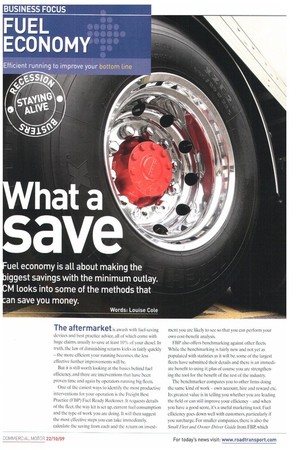uel economy is all about making the iggest savings with
Page 46

Page 47

If you've noticed an error in this article please click here to report it so we can fix it.
the minimum outlay. M looks into some of the methods that an save you money.
Words: Louise Cole
The aftermarket is awash with fuel-saving devices and best practice advice, all of which come with huge claims, usually to save at least 10% of your diesel. In truth, the law of diminishing returns kicks in fairly quickly — the more efficient your running becomes, the less effective further improvements will be.
But it is still worth looking at the basics behind fuel efficiency, and there are interventions that have been proven time and again by operators running big fleets.
One of the easiest ways to identify the most productive interventions for your operation is the Freight Best Practice (FBP) Fuel Ready Reckoner. It requests details of the fleet, the way kit is set up, current fuel consumption and the type of work you are doing. It will then suggest the most effective steps you can take immediately, calculate the saving from each and the return on invest
ment you are likely to see so that you can perform your own cost-benefit analysis.
FBP also offers benchmarking against other fleets. While the benchmarking is fairly new and not yet as populated with statistics as it will be, some of the largest fleets have submitted their details and there is an immediate benefit to using it plus of course you are strengthening the tool for the benefit of the rest of the industry.
The benchmarker compares you to other firms doing the same kind of work — own account, hire and reward etc. Its greatest value is in telling you whether you are leading the field or can still improve your efficiency — and when you have a good score, ifs a useful marketing tool. Fuel efficiency goes down well with customers, particularly if you surcharge. For smaller companies, there is also the Small Fleet and Owner Driver Guide from FBP, which
highlights the easiest steps you can Lake for minimum outlay, including: • Driver training • Anti-idling • Vehicle specification • Aerodynamics • Fuel efficiency Lyres and wheel alignment • Preventative maintenance
Tyres
Tyre management is one of the easiest ways to make a difference to your fuel bill, because 30% of your fuel is used to overcome rolling resistance. The other two great forces trucks have to push against are aerodynamic resistance and mechanical friction.
Choosing the right tyre for your application is essential to get the correct balance between durability and rolling resistance. Regrooved tyres tend to have a lower rolling resistance than new ones, so it's worth investing in second-life product.
There are four factors that determine fuel efficiency in tyres: proper inflation; wheel alignment in relation to the vehicle; remaining tread depth; and construction.
A tyre that is 10% under-inflated will use 1.5% more fuel. Michelin suggests that 58% of tyres in the UK are 10% under-inflated. Operators should not assume that even new vehicles' tyres are properly inflated because tyre pressure is affected by storage conditions and temperature. The correct level of inflation also depends upon the truck's task. Check with your tyre supplier.
If a wheel is even 1% misaligned, it can add 3% to your fuel hill because you are effectively dragging an axle.
Tyres have the lowest rolling resistance when the tread is worn and are often at their most efficient just before removal, Regrooving can be a safe way of extending this sweet spot, although the original construction of the tyre and its amount of base rubber does affect its quality and suitability for regrooving. •
















































































































































